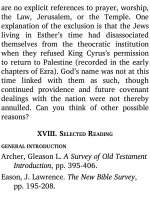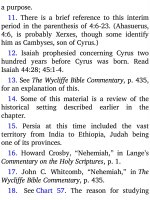Jensens survey of the old testament adam 53
Bạn đang xem bản rút gọn của tài liệu. Xem và tải ngay bản đầy đủ của tài liệu tại đây (120.72 KB, 4 trang )
Bible Commentary.
1. Theologians refer to this as creation ad
extra.
2. W. Graham Scroggie, Know Your Bible, 1:22.
3. Oswald T. Allis, The Five Books of Moses, p.
288.
4. Merrill F. Unger, Introductory Guide to the
Old Testament, p. 274.
5. This is the traditional view, strongly
supported by both internal and external
evidence.
6. There is archaeological evidence of the art
of writing in the ancient Near East dated as
early as the fourth millennium B.C., which was
long before Moses’ time.
7. G. T. Manley, The New Bible Handbook, p.
116.
8. D. A. Hubbard, “Pentateuch,” in The New
Bible Commentary, p. 964.
9. The rst forty years (1525-1485 B.C.) of
Moses’ life were spent in Pharaoh’s court. The
next forty years (1485-1445 B.C.) saw him in
exile in Midian (see Map F).
10. Dates are from John C. Whitcomb’s chart,
Old Testament Patriarchs and Judges.
11. Each full chapter of Genesis is a study
segment, with these exceptions: chapter 25 has
two segments, 25:1-18 and 25:19-34. Also, the
segment of chapter 37 begins at 37:20. Mark
these in your Bible now.
12. The word “generations” in this phrase
signifies “that which is begotten.”
13. Manley, p. 126.
14. There is no way of knowing how long this
interval was, even though the genealogical
listings include time data.
15. Latin for “let it be done.”
16. See Edward J. Young, Introduction to the
Old Testament, p. 54.
17. Cf. John 8:44.
18. The word Semitic is derived from the name
Shem. Some think the word Hebrew can be
traced to Eber, great-grandson of Shem (Gen
11:14).
19. Merrill F. Unger, Unger’s Bible Handbook,
p. 63.
20. Steven Barabas, “Isaac,” in The Zondervan
Pictorial Bible Dictionary, p. 383.
21. Paddan-Aram is either the region where
Haran is located, or another name for Haran
itself. See Map A for the location of Haran.
22. In the land allotments to the tribes, the
sons of Levi (Levites) were given no land
inheritance. Also, Joseph was represented in two
shares of territory by his sons, Ephraim and
Manasseh.
23. See John F. Walvoord, Jesus Christ Our
Lord, pp. 62-78, for a good discussion of this
subject.
24. Scroggie, 1:22.
4









